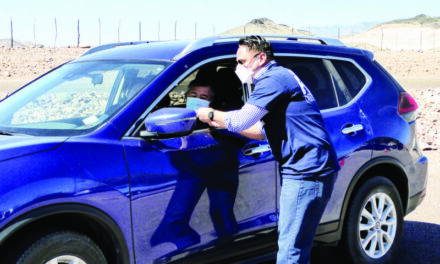
When completed, the Magdalena Ridge Observatory Interferometer is expected to produce images at resolutions over 100 times that of the Hubble Space Telescope.
Artist conception courtesy MROI/New Mexico Tech
A project that dates back to 2002 continues to take shape on South Baldy Mountain at New Mexico Tech’s Magdalena Ridge Observatory Interferometer (MROI).
According to its designers, the MROI is an “astronomical installation ultimately involving an array of 10 telescopes that, when completed, is expected to be 100-200 percent stronger than the Hubble telescope.”
The first dome was installed in 2018 and “first light” was achieved that year.
Now, thanks to new congressional funding, astronomers at Tech are getting one step closer to seeing completion of the envisioned 10 telescope array.
According to a press release from the Air Force Research Laboratory, New Mexico Tech has been awarded a $30 million cost-reimbursement cooperative agreement for Magdalena Ridge Observatory Interferometer. The contract provides for additional telescope production, the demonstration of fringe tracking, and imagery production of objects in geosynchronous Earth orbit. Work is expected to be completed by Dec. 31, 2026.
The initial disbursement funds of $6,285,000 are being obligated to research, development, test and evaluation – the first phase of the $30 million five-year project to build three telescopes and two scientific instruments of the MROI.
Tech has received congressional funding over the past several years in support of the university’s astronomy program. The Air Force Research Laboratory Space Vehicles Directorate at Kirtland AFB manages the funding contract.
“When complete, the project will improve detection and characterization of objects at Geosynchronous Earth Orbit and beyond,” said Van Romero, vice president for research and professor of physics at New Mexico Tech. “It will allow astronomers to assess the health and orientation of man-made objects and study starspots, newly forming planets around young stars, and accretion disk physics around super-massive black holes.”
Originally, the concept was to build the 2.4-meter telescope – in operation since 2006 – to be part of an interferometer. According to MROI Project Director Ifan Payne, that all changed in 2002 when Tech joined with the Cavendish Laboratory, the physics department at the University of Cambridge.
“The systems’ architects there designed the interferometer to be “a Y-shaped configuration with 10 telescopes,” Payne said in a 2018 interview.
The funding will support a team of more than 40 scientists, engineers, students and project support staff. Composed primarily of researchers and students from New Mexico Tech, the team will collaborate with the University of Cambridge in the United Kingdom and is in partnership with AFRL.
“AFRL, which supports both the Air Force and Space Force, can benefit through collaboration with academia on congressionally funded projects,” said Brian Engberg, who leads AFRL’s Space Control Branch. “If successful, this effort will enable us to leverage new, innovative sensing instruments that, while directly advancing astronomical sciences, could also augment space domain awareness and defense.”
Resolution would be equivalent to a 380-meter mirror, which for all practical purposes, Romero pointed out, would be all but impossible to construct.
According to Payne, when fully realized, the MROI will make images of unprecedented detail of the center of the galaxy, regions of star and planet formation, stellar accretion discs, and active galactic nuclei, as well as satellites in geosynchronous orbit.
“The MROI will be able to make accurate and detailed images of complex astronomical objects up to 1,000-times faster than other previous or current interferometric arrays,” Payne says.
When complete, the MROI will be one of the largest Earth-based optical telescopes, made up of an array of 10 collecting mirrors, working together to produce images with resolutions equal to a single telescope more than three football fields across.
“We are excited that the MROI has the potential to push New Mexico into the lead in space exploration as well as training young scientists and engineers for the future of space both for the public and private sectors, creating a path for New Mexico’s best and brightest graduates to remain in the state,” Romero said.
Expected to be completed in 2026, the project has been uniquely designed to work more efficiently, and provide higher resolutions and sensitivities than equivalent telescope arrays being used today.
“This is a technique capability that cannot be equaled from space today,” Romero said.
The initial mission of the Interferometer is three-fold. In addition to science – astronomy and learning more about the universe – the MROI will be tasked with imaging geosynchronous satellites. The third benefit will be education and outreach, including K-12 courses and tours, supporting the university’s Astrophysics Department and special events for the public.
NMT will also promote collaboration with other state, regional, national and international universities.
Partners in the project are the University of Cambridge and the U.S. Air Force.The Magdalena Ridge Observatory is located on 1,000 acres at 10,600 feet in the Magdalena Mountains of the Cibola National Forest.












